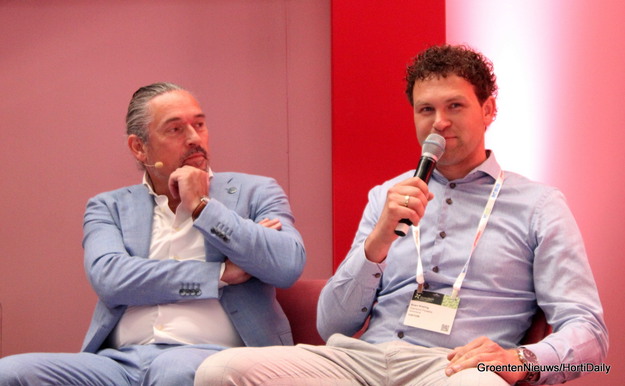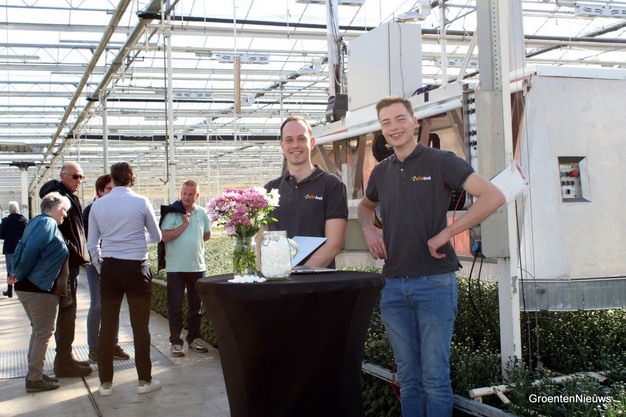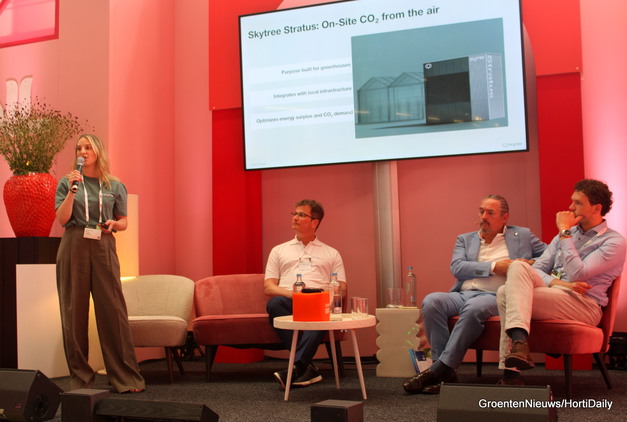Significant innovations are needed to realize the ambitions outlined in The First Sustainable Generation manifesto. That was the message delivered by Annie van de Riet, Chair of AVAG, during the Dutch Summit on Dutch Growers' Day at GreenTech Amsterdam 2025. The summit saw the official presentation of the manifesto's fresh narrative on sustainability, followed by a showcase of several innovation award winners who were invited on stage to present themselves and their companies.

Labor and energy: main challenges
For Koen, a grower at Diamond Flowers (part of Kreling Chrysanten), labor and energy are currently the most pressing challenges. Speaking at the event, he predicted that within five years, chrysanthemums could be grown at scale using a mobile cultivation system. Koen has already gained small-scale experience with such a system involving rolling benches equipped with ebb and flood irrigation. Once his new greenhouse is built, he plans to scale up.
Chrysanthemums, much like potted plants, lend themselves well to being grown in pots on rolling tables, Koen noted. This setup allows the crop to move to the robot, rather than the robot to the crop, a concept that's also being explored by Saia Agrobotics in tomato cultivation.
Koen has also experimented with a bud-cutting robot developed by Wikotech. The prototype was recently showcased during the "Kom in de Kas" event at Kwekerij De Wolvenhoek. The first commercial version of the robot was delivered during GreenTech week to Henda Flowers, where it will now undergo an extended trial.
 © Thijmen Tiersma | MMJDaily.comDemonstration of the bud-cutting robot for chrysanthemums by Wikotech at Kwekerij de Wolvenhoek
© Thijmen Tiersma | MMJDaily.comDemonstration of the bud-cutting robot for chrysanthemums by Wikotech at Kwekerij de Wolvenhoek
CE-Line already has commercial systems in the field, enabling real-time lab-grade analysis of nutrient levels in irrigation and drain water. One user, Plantenkwekerij Gitzels, reported noticeable savings on fertilizer costs, according to grower Mike Gitzels in a recent interview with Greenport Noord-Holland Noor.
Camille Hanna (Skytree). View all photos from GreenTech Amsterdam 2025 here.
CO₂
While Koen flagged energy as a major concern, CO₂ availability is also emerging as a critical issue for growers transitioning away from fossil fuels. With that in mind, Skytree is developing technology to capture CO₂ directly from ambient air. The company won the GreenTech Innovation Award with its Stratus system, which offers greater capacity than its predecessor, the Cumulus, another award-winning innovation.
The Cumulus system has been tested at WUR in Bleiswijk, where the captured CO₂ was trialed in a cucumber greenhouse. Research goals included assessing the quality of the CO₂, identifying any plant safety risks, evaluating system integration, and studying overall compatibility with the greenhouse environment. Results showed the CO₂ was safe and effective, and the condensation water produced during capture could potentially be reused for irrigation. However, energy consumption remains a concern, especially since the original system wasn't specifically designed for greenhouse use, a gap the Stratus does aim to fill.

Crop protection
ViewNetic CEO Ido Dor took the stage to accept the Concept Award. His company is shifting crop protection from reactive to preventive by leveraging artificial intelligence. The ViewNetic platform identifies threats early, turns real-time data into actionable insights, and provides timely, accurate recommendations, helping growers reduce costs, enhance crop value, and operate more sustainably.
Central to the ViewNetic approach is a scouting robot capable of detecting even the smallest pests at an early stage. Dor demonstrated that the robot can identify a single mite egg. For lower-tech environments, where such robots may not be feasible due to the absence of level pipe rails, a common challenge for greenhouse robotics, ViewNetic also offers a handheld tool. This device allows workers to walk through the crop and collect valuable data, effectively turning the scout into the robot.
According to Ido, ViewNetic aims to launch its platform solution in early 2026. The system has already been tested in various fruiting vegetable crops and several ornamental crops as well.
For more information:
CE-Line
sales@ce-line.com
www.ce-line.com
Kreling Chrysanten
info@krelingchrysanten.nl
www.krelingchrysanten.nl
Skytree
info@skytree.eu
www.skytree.eu
ViewNetic
www.view-netic.com

